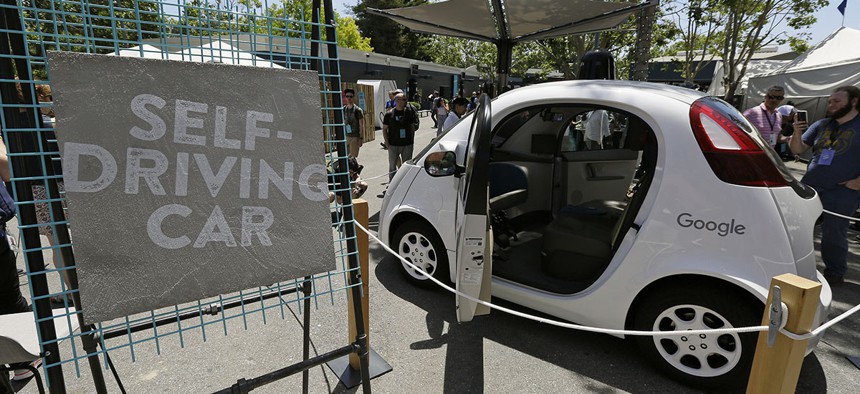Google’s Self-Driving Cars Will Be Able to Take Over From Human Drivers at the Push of a Button

A Google self-driving car is seen on display Wednesday, May 18, 2016, at Google's I/O conference in Mountain View, Calif. Eric Risberg/AP
Like cruise control, but better.
For anyone driving long distances, cruise control is fantastic. Pressing a button, letting go of the accelerator, and focusing on the road ahead makes long drives a little more bearable. According to a new patent published today, Google wants to make self-driving cars just as simple to use.
The patent outlines the system passengers will use to turn on and off the self-driving functions in Google’s self-driving cars. Like cruise control, autonomous driving will essentially involve making sure it’s safe to shift into self-driving mode, and then pressing a big “ON” button to let the car drive itself.
In the patent, if a human requests that the car go into autonomous mode, the car will check its surroundings and the car’s status to ensure it’s in a position to take over driving.

Tap to it.(US Patent and Trademark Office)
According to the patent, the car needs to be shifted into “drive” (meaning it apparently can’t take over while the car is parked), that the windshield wipers and lights have to be set to “auto” mode, and the car needs to be in the middle of an open lane, and the car isn’t going too fast. (For what it’s worth, Google’s current cars are limited to 35 mph.)
The driver will be shown all of these conditions that need to be met before the car can take over on a display screen on the car’s center console. The patent also suggests that autonomous mode could be disengaged if someone starts turning the steering wheel, or pushing the accelerator—similar to how cruise control can be deactivated on today’s cars.
The patent also suggests that the car may decide it’s not safe to hand back control to a human—if the car is driving through a sharp turn, for example—which could lead to more robots making important decisions for us, which probably won’t end so well for us.
Google wasn’t immediately available to comment on whether this system would appear in the self-driving minivans it’s working with Fiat-Chrysler on, or the panda-shaped cars it built that are currently roaming the streets of Silicon Valley.
But as cars become more and more autonomous—think Tesla’s “autopilot” mode, which is already available—there perhaps may come a time when we won’t need driving licenses to drive cars. We’ll just need to know how to push a few buttons to get where we’re going.


